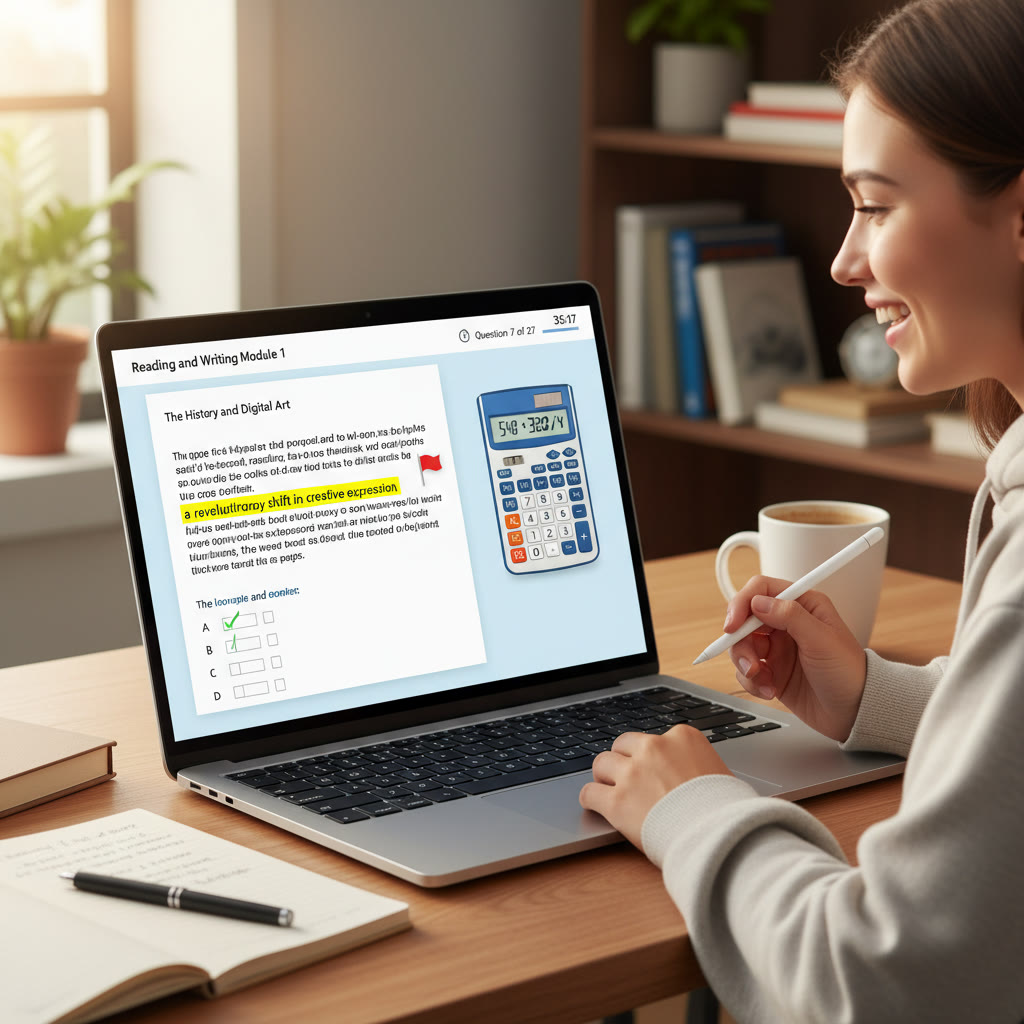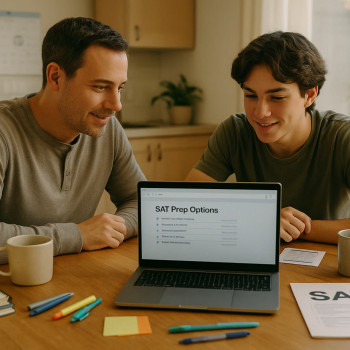Welcome to the Future of Testing: The Digital SAT Through a Student’s Eyes
Walk into a room with a charged device, a quiet corner, and the hum of focused students — now imagine the familiar sheet of densely printed bubbles has been replaced by a clean, interactive screen. The Digital SAT interface is more than a technological update; it’s a different rhythm, a new set of gestures, and, for many students, a change in how they think about pacing, annotation, and review.
This post is a humane, practical guide to that experience. We’ll explore what students notice first, the small frictions that can make or break a practice session, and the tools and strategies that help. Along the way I’ll share examples, a comparison table, and actionable routines. Where it fits naturally, I’ll mention how Sparkl’s personalized tutoring — 1-on-1 guidance, tailored study plans, expert tutors, and AI-driven insights — can help make the transition smoother.
First Impressions: The Interface as a Comfortable Stranger
The first time a student clicks into the Digital SAT, common reactions cluster around three things: clarity, unfamiliarity, and relief.
- Clarity: Modern digital layouts tend to reduce visual clutter. Passages can appear with adjustable font sizes, and questions are presented one after another. For many students, that feels calming compared to long paragraphs printed on paper.
- Unfamiliarity: Buttons, flags, and onscreen calculators are novel. Students who are used to pencils must learn to highlight, mark, and flag using taps or clicks instead of marginalia.
- Relief: No more smudged erasers or frantic bubbling. Digital answer recording removes the fear of misbubbling — but introduces a new anxiety: mastering the navigation tools so you don’t lose precious time.
What Students Notice First
- Where the timer lives and how it counts down.
- How to flag a question for review.
- The on-screen calculator and any available scratch tools.
- Whether they can move freely between questions and modules.
Core Interface Features and Student Reactions
Let’s break down the main features students will encounter and how they typically react. These features shape not just how you answer questions, but how you plan your entire test strategy.
Navigation and Modules
The Digital SAT is organized into timed modules. Each module contains a block of questions; performance in an earlier module can influence the difficulty of the next. Practically, that means:
- Students must be strategic in the first module: it sets the stage.
- You often see a progress bar and the ability to jump between questions within the same module, but moving between modules may be restricted.
- Many students feel a brief spike of anxiety when they recognize that one module can steer the test — which is why realistic, timed practice is essential.
Flagging, Highlighting, and Annotation
On-screen flagging replaces dog-eared corners. Highlighting becomes digital selection. Students quickly learn a few micro-habits:
- Flag questions they want to return to — a digital post-it that never smudges.
- Use highlighting to mark keywords in passages (where the interface supports it).
- Create a consistent annotation routine: always underline hypothesis sentences, always circle numbers in math problems. Consistency reduces cognitive load.
On-Screen Calculator and Scratch Space
One big change is the reliable presence of a digital calculator during math questions. Many students welcome this, but it comes with trade-offs:
- Built-in calculators are convenient but sometimes slower to manipulate than a physical calculator you know by muscle memory.
- Scratch paper is still allowed in many test settings, and combining quick physical jotting with the on-screen calculator is a common tactic.
- Practice toggling between the calculator and question text until it’s second nature.
Timer and Pacing Tools
The timer is both friend and foe. It’s helpful because it keeps you honest about time; it’s tricky when you spend too much time staring at it. Students learn to:
- Break the time into mini-sprints (example: tackle this five-question set in 12 minutes).
- Use the visual progress indicator (if present) rather than the second-by-second countdown — the broader view reduces anxiety.
How Digital Changes the Rhythm of Test-Taking
Transitioning from paper to screen changes more than the tools; it changes the rhythm. Consider two students: Maya, who works at a steady, methodical pace; and Jamal, who is a fast skimmer with strong intuition.
- Maya benefits from being able to highlight and flag; her methodical habit is amplified by clear, legible text and the ability to jump back within a module.
- Jamal may need to adapt his skimming style because screen reading can feel different from paper. Shorter passages and chunked questions can help him keep momentum without sacrificing accuracy.
Both students can benefit from practicing with full-length, timed digital tests so their internal rhythm aligns with the interface’s constraints.
Real-World Context: Why this rhythm matters
Think of the interface as the concert hall and your strategies as the orchestra. The hall’s acoustics (visual layout, timers, tools) will change how an orchestra plays. A conductor who has rehearsed in that hall will lead with confidence. Similarly, a student who has rehearsed on the Digital SAT interface will enter the test with fewer surprises.
Practical, Step-by-Step Prep Routine for Mastering the Interface
Here’s a routine you can adopt for the two months leading up to your test. It’s designed to make the interface feel familiar and to build habits that translate to test day.
- Week 1–2: Orientation
- Spend one hour exploring the interface without time pressure. Learn where the timer, flag button, calculator, and review panel are.
- Practice basic navigation: flag, highlight, and move between questions within a module.
- Week 3–4: Short Drills
- Do 30–45 minute timed drills that mirror a single module. Focus on becoming nimble with the calculator and annotation tools.
- Week 5–6: Full Practice Tests
- Take at least two full, timed digital practice tests. Recreate test-day conditions (charged device, no phone, quiet space).
- After each test, review how much time you spent on flagged questions and adjust pace strategies.
- Week 7–8: Polishing and Simulation
- Schedule a final dress rehearsal under realistic conditions. Practice managing stress and the rhythm of the modules.
- Use targeted sessions with a tutor (1-on-1) to iron out recurring interface-related errors — for example, accidentally leaving a question unsubmitted. Tutors can offer individualized cues and adaptive strategies.
Common Surprises and How to Handle Them
Students often encounter similar hiccups the first few times they sit for a digital practice test. Here are common surprises and practical fixes.
Surprise: Lost Time in Navigation
Fix: Practice frequent, timed drills where you force yourself to flag and move on if you exceed a target time on a question. This trains your muscle memory for the “flag-and-move” decision.
Surprise: Overreliance on Calculator
Fix: Do pencil-and-paper style practice for some math questions, then transfer the same problem to the digital calculator — this builds number fluency and reduces time spent entering numbers.
Surprise: Screen Fatigue
Fix: Train your eyes with focused reading intervals. Use the same screen brightness you’ll use on test day, and take healthy breaks during practice to reduce strain. Physical scratch paper helps offload cognitive load from the screen.
Sample Time Allocation: A Practical Table
Below is a sample time allocation for a single module or a short section of questions. Use it as a starting point; adapt it based on your speed and question mix.
| Task | Approximate Time | Why it Helps |
|---|---|---|
| Read question and scan answers | 30–45 seconds | Quick comprehension and elimination; avoids wasted calculation time. |
| Attempt methodical solution | 60–90 seconds | Allows for disciplined problem solving and calculation as needed. |
| Quick review and enter answer | 15–30 seconds | Reduces simple transcription or entry mistakes. |
| Flag and move on if stuck | 10–15 seconds | Preserves time for solvable questions and limits time-sink items. |
How Tutoring Fits Naturally Into the Digital Experience
One-on-one tutoring can make a dramatic difference, not because the interface is hard, but because personalized coaching accelerates the formation of reliable habits. A tutor can:
- Observe your interface-induced bottlenecks and give targeted drills.
- Create a tailored study plan that emphasizes the interface elements you struggle with (like flagging discipline or calculator efficiency).
- Provide AI-driven insights where available — for instance, highlighting recurring timing patterns — and translate those into human guidance.
Programs like Sparkl’s personalized tutoring combine expert tutors with AI-driven insights and tailored study plans to help a student focus practice sessions precisely where they’ll yield the biggest gains. That human + tech blend helps students convert practice into reliable test-day performance.
Putting It All Together: A Day-of-Test Checklist
- Charge your device fully and bring the charger; turn off auto-updates that could restart your device.
- Confirm the testing app/browser is updated and that you can access the practice environment.
- Have at least two pens/pencils and permitted scratch paper if allowed in your test setting.
- Rehearse your pre-test routine: a short warm-up, a quick review of timing goals, and a calm two-minute breathing exercise.
- Avoid learning new interface tricks on test day. Stick to what you practiced.
Student Stories: Mini Case Studies
Real experiences help make abstract advice tangible. Here are two short, anonymized snapshots.
Case Study 1: Ana — From Hesitant to Confident
Ana worried about the on-screen calculator and whether she’d accidentally mis-enter numbers. Her tutor recommended a 15-minute daily drill that involved solving mental arithmetic problems on paper and then reproducing them using the digital calculator. After a week, Ana’s entry time dropped, and she felt less tempted to double-check trivial operations. On test day, she completed her math module with calm confidence.
Case Study 2: Leo — Mastering Flag Discipline
Leo had a habit of lingering on a single hard question until the time evaporated. Together with his tutor, he adopted a strict rule: if a question hit a two-minute limit without progress, flag and move on. Practicing that rule in mock modules helped him recover many points that would otherwise be lost to overthinking.
Final Thoughts and a Gentle Invitation
The Digital SAT interface asks students to be deliberate about new micro-skills: clicking instead of ripping out a page, flagging instead of folding a corner, toggling between calculator and question text instead of reaching for a familiar handheld tool. These micro-skills are learnable. The secret is to practice them under realistic conditions until they become second nature.
If you’re building those habits and want targeted help, consider supplementing practice with focused 1-on-1 sessions. Tutors who understand both the content and the interface can speed your progress, using tailored study plans and data-driven feedback (AI-driven insights included) to prioritize what matters most.


Take a deep breath. Treat the interface as a tool, not a test of your adaptability. With the right practice, a few tried-and-true rhythms, and occasional personalized coaching, you’ll find that the Digital SAT is less of a technological leap and more of an opportunity to show what you know — calmly, clearly, and confidently.
Good luck, and remember: your preparation is a marathon of steady habits, not a sprint of last-minute tricks. Build a routine, rehearse in the real environment, and let small, consistent improvements stack up into real, measurable gains.















No Comments
Leave a comment Cancel